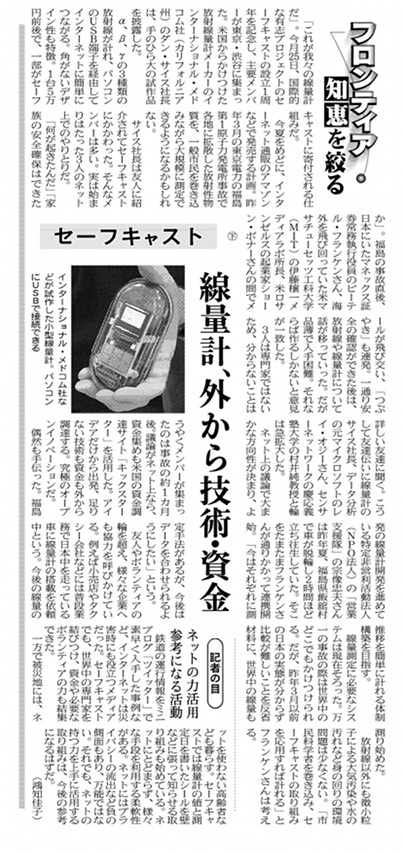Introduction by the translator: The following is an unofficial English translation of the original article in Nikkei Sangyo Shimbun a Japanese newspaper about industrial matters. The Nikkei group also publishes the Nihon Kezai Shimbun which is the major financial newspaper of Japan. Please note that the journalist solely used the term “Senryokei” to describe radiation measurement equipment (which includes geiger counters, but is a wider, more general term). There is no mention in the article about Safecast’s bGeigie system (of which the geiger counter “survey meter” is only a part of the total) continuously recording sets of GPS-coordinates and radiation levels that gets uploaded to the internet “as-is” under a Creative Commons CC0 1.0 license for everyone to observe, download, and use freely without any limitations.
Safecast Survey Meter – Technology and Funds from Outside Sources
“This is our new survey meter”, said Dan Sythe, President of International Medcom in California, presenting a palm-size prototype of a new survey meter. On March 25, 2012 core members of Safecast, an international volunteer group, gathered in Shibuya, Tokyo to celebrate their group’s one year anniversary.
The survey meter measures alpha, beta, gamma rays and can be easily connected to the internet via USB. It has a characteristic design with no sharp edges. The price will be around 50,000 yen and part of each sale will be donated to Safecast.
It will be sold on the Amazon internet site from sometime this summer, and it may make more of the general public participate in radiation measurements to facilitate large scale measurement of the radiation that was dispersed in various places after the nuclear power accident at the Fukushima Dai-ichi in March 2011.
Dan Sythe got involved in Safecast through his friend. Several Safecast members got involved in the same way. Safecast started from the online communication of only three individuals. Right after the nuclear power accident Pieter Franken, CTO of Monex Securities Co., Joichi Ito, known for his extensive activities in foreign countries, currently Director of MIT Media Lab, and Sean Bonner, a Los Angeles based entrepreneur, exchanged e-mails and tweets: “What has happened?” “Did you make sure your family is safe?” Their conversation shifted to the subject of radiation and that survey meters to measure radiation were scarce and hard to get hold of. They agreed that they have got to make one by themselves.Safecastの活動が2012年3月28日の「日経産業新聞」に取り上げられました。

They were not experts in survey meters so they asked others with know-how in this field. Soon their circle of friends extended to Dan Sythe, Ray Ozzie, ex Chief Software Architect at Microsoft, Jun Murai, Professor of Keio University in charge of Sensor Networks.
They discussed the outline of their project online and the members gathered one month later. Fundraising was also done via the internet at fundraising site “Kickstarter”. They started with ideas and obtained technology and funds from outside sources. This is ultimate form of open innovation.
An interesting coincidence happened: Last summer Tadao Munakata, a member of an NPO organization, was stranded along a road for two hours due to car trouble. Franken happened to drive by, and that’s how their affiliation started. Franken says they were using different radiation measurement methods, however from now on he wants to make it possible to integrate the data collected by either system.
Safecast has reached out to businesses for cooperation beyond the circle of friends and volunteers. For example, they have asked retail stores and a taxi company to mount their survey meter for the purpose of building a structure to easily measure how the radiation levels changes over time. They have completed a system for comprehensive continuous measurement of radiation levels, and they are able to go anywhere if another nuclear power accident occur. However, they realised that the lack of radiation measurement data from before March 11, 2011 makes it difficult to compare the radiation levels before and after March 11, and therefore they have started measuring radiation levels in other countries.
There are other environmental issues than radiation, like for example air and water pollution. Franken says it is possible to measure the level of pollution by applying the same approach as that of Safecast by involving citizen scientists.